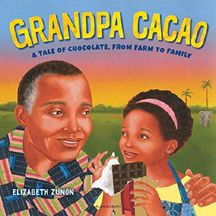The picture book begins with a young girl, presumably in the U.S., making a chocolate cake with her father. As they blend the ingredients, father tells her about her Ivorian grandfather and his cacao farm. Father notes his role as a 7-year-old, working with others in the village gathering and scooping out cacao pods after his schoolwork and chores were done.
As he grew older, he helped Grandpa Cacao bag the beans to sell to cacao buyers. The money the family earned bought food, school supplies, uniforms, books, and fabric for special occasion clothes. The story ends with a sweet surprise. Grandpa Cacao arrives from Ivory Coast wearing kente cloth and looking very much like the girl and father in the story and the real Elizabeth (who wrote and illustrated the story).
Elizabeth Zunon’s text and illustrations do an excellent job of showcasing this satisfying family story and capturing the time-consuming, labor-intensive process cacao farming entails. She makes it easy to identify Grandpa Cacao as a young man by representing him and the village cacao workers in white, opaque screen-print shapes. Zunon explains that she used the opaque technique to show how Grandpa “exists in the little girl’s imagination as an almost mythical figure.” The tropical backgrounds of the cacao plantation and the contemporary scenes are done in oil paint on watercolor paper with collage elements.
Cacao farming is a popular research topic in U.S. schools. Most magazine and newspaper articles focus on the exploitation of children in Ivory Coast who are forced to work long hours with dangerous, sharp tools. Students generally come away from this research with negative images of Ivory Coast in particular and Africa in general.
Zunon is to be commended for the balanced way she handles the topic. She describes the problems in the industry in her Author’s Note, separating the tough realities from the story she is telling young children. She puts the problems of the cocoa trade into historical context by pointing to the colonial history of forced labor and noting the efforts by local and international actors to address the issues.
Children’s Africana Book Award’s Grandpa Cacao Reviewed and Other Winners Announced
Reviewed by CABA Committee, Edited By Brenda Randolph
Reviewed by CABA Committee, Edited By Brenda Randolph

Grandpa Cacao’s farm shows that not all cocoa farms are or have been exploitative enterprises. Collective labor done by adults, shared benefits, and the use of children as helpers with appropriate tasks are hallmarks of farms, past and present, that adhere to fair trade principles. Information about exploitative farms and child labor in Ivory Coast should not be ignored. The problems should be integrated into the study of exploitative labor practices in other parts of the world including the U.S.
Note: Illustrator Elizabeth Zunon has illustrated more than 15 books, three of which have received Children’s Africana Book Awards (CABA): The Boy Who Harnessed the Wind by William Kamkwamba, One Plastic Bag: Isatou Seesay and the Recycling Women of the Gambia by Miranda Paul and this book, Grandpa Cacao, A Tale of Chocolate, from Farm to Family.
Grandpa Cacao, the first book Zunon has both authored and illustrated, highlights her Ivorian-American background. She grew up in her father’s home country of Ivory Coast until the age of twelve when the family moved to her mother’s home in upstate New York.
28th Annual Children’s Africana Book Award winners
African Access, Children Africana Book Awards (CABA), and Read Africa Week: The national observance of Read Africa week during the first week of February, Black History Month, is advocated by Africa Access. Africa Access vets the suggested books the Read Africa Week suggests participants to read, holds the annual Children’s African Book Awards, and the annual Children Books Awards Festival at the Smithsonian National Museum of African Art in April.
Read Africa Week is celebrated in many locations including the Francis Gregory Library in DC, which is co-sponsored by the Port Of Harlem Gambian Education Partnership.
See a video of Zunon discussing the creation of Grandpa Cacao with Brenda Randolph.
READ AFRICA Scholar Recommended Reads
Note: Illustrator Elizabeth Zunon has illustrated more than 15 books, three of which have received Children’s Africana Book Awards (CABA): The Boy Who Harnessed the Wind by William Kamkwamba, One Plastic Bag: Isatou Seesay and the Recycling Women of the Gambia by Miranda Paul and this book, Grandpa Cacao, A Tale of Chocolate, from Farm to Family.
Grandpa Cacao, the first book Zunon has both authored and illustrated, highlights her Ivorian-American background. She grew up in her father’s home country of Ivory Coast until the age of twelve when the family moved to her mother’s home in upstate New York.
28th Annual Children’s Africana Book Award winners
African Access, Children Africana Book Awards (CABA), and Read Africa Week: The national observance of Read Africa week during the first week of February, Black History Month, is advocated by Africa Access. Africa Access vets the suggested books the Read Africa Week suggests participants to read, holds the annual Children’s African Book Awards, and the annual Children Books Awards Festival at the Smithsonian National Museum of African Art in April.
Read Africa Week is celebrated in many locations including the Francis Gregory Library in DC, which is co-sponsored by the Port Of Harlem Gambian Education Partnership.
See a video of Zunon discussing the creation of Grandpa Cacao with Brenda Randolph.
READ AFRICA Scholar Recommended Reads
Advertisers | Contact Us | Events | Links | Media Kit | Our Company | Payments Pier
Press Room | Print Cover Stories Archives | Electronic Issues and Talk Radio Archives | Writer's Guidelines






